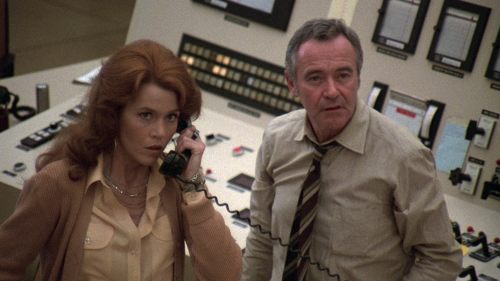K-19: THE WIDOWMAKER: Soviet Nuclear Disaster, Bigelow Style
Chernobyl was the first nuclear accident the Soviet Union ever admitted occurred, but it was far from the first to actually take place. Numerous failures, meltdowns, and explosions had befallen reactors around the USSR in the decades prior to Chernobyl - including, incredibly, one in a different reactor at Chernobyl. Those stories have barely been told in non-fiction print, let alone in dramatic cinema. One of the few that has: that of the Soviet nuclear-powered submarine K-19, in the form of Kathryn Bigelow’s K-19: The Widowmaker.
Barely anybody saw K-19 when it released in 2002. With a budget of a hundred million dollars (the most expensive independent production ever, at the time), it died a miserable death at the box office. So disastrous was its release, Bigelow vanished from the scene for six years, only returning (and winning Oscars) with the decidedly lower-budget The Hurt Locker. But in the wake of HBO’s Chernobyl, it’s worth revisiting, for it offers a vastly different take on a Soviet nuclear accident and the ensuing response.
K-19 was different to Chernobyl in most ways, just as K-19 is different to Chernobyl in most ways. Taking place in a flagship nuclear submarine, the accident saw one of the boat’s two reactors lose coolant pressure, with reactivity and temperature rising dramatically. A tamer accident than Chernobyl’s core explosion, then, but one exacerbated due to taking place inside a submarine. The crew had to manually redirect coolant - a task that involved sloshing around in the reactor room's radioactive water and welding new pipes - while radiation from the supercritical reactor permeated the interior of the sub. Several men died soon afterward; more died prematurely later in life.
Bigelow’s film reshapes that story into a surprisingly traditional Hollywood story of heroism and sacrifice. The cinematography is robust, evenly-lit, and traditional, not far removed from any other action-thriller of the time, and despite filming in a real submarine, never quite feels as claustrophobic as, say, Das Boot. Klaus Badelt’s rousing score underlines the heroism of the men who worked to prevent disaster, where Hildur Guðnadóttir’s eerie Chernobyl score simply allows events to play out. Bigelow gets the job done, but there’s little unique style on display here.
Casting Harrison Ford and Liam Neeson as the submarine’s captain and executive officer, respectively, certainly helps glamourise the events, no matter how shaky their Russian accents. Even baby Peter Sarsgard, as K-19’s fresh-faced and cripplingly nervous reactor engineer, is given a hero moment as he finally overcomes his fear and enters the reactor room. That, in turn, feeds into a hero moment for Ford’s character, who goes through the airlock without protection in order to extract his crewman. It’s entirely possible these actions took place in real life, but their presentation feels over the top. The characters of K-19 and Chernobyl both make sacrifices, but only K-19 actively lionises them, the tragedy playing second fiddle to heroism.
Perhaps most egregious is the film’s coda, wherein Ford’s character emotionally reunites with his crew, decades after the incident. The scene is framed as a respectful recognition of the crew’s contributions, but the focus on Ford's character only further lifts him up as the film’s primary hero - a status that began with the casting itself. That coda, however, wouldn’t exist were it not for the inconveniently anticlimactic course of the actual events. There was no big climax; no profound character turn; no explosion (thankfully). The submarine was towed back to base, repaired, and sent out for continued use, incredibly accumulating more accidents over the decades. The crew lived out their lives, if they survived the accident. And like every other reactor failure up until Chernobyl, the accident was covered up. Everything just fizzled into Party-mandated silence. Bigelow clearly struggled with how to end her movie, given those circumstances. The coda probably seemed the best way to do it, but it puts a weird victorious spin on lives that probably didn’t feel victorious at all.
The effects of acute radiation sickness are, if anything, downplayed in K-19. Its depiction of ARS - mostly vomiting, burns, and dizziness - probably seemed horrendous to audiences expecting a Harrison Ford submarine thriller. Compared to Chernobyl’s gruesome makeup effects, though - enough to spark nausea on their own - it seems tame, especially given that some of these men received at least twice the lethal dose of radiation. Granted, the truly awful effects wouldn't have set in until a few days later, but if K-19 - which features men working in direct contact with a nuclear reactor - was intended to illustrate the danger and effects of radiation exposure, it failed to do so.
Surprisingly, Bigelow’s curiosity about complex political and military situations falters somewhat in K-19. Her trademark attention to authenticity is on full display - the film shot inside an actual Soviet submarine, albeit a diesel-electric one - but so is her willingness to bend the truth. A mutiny among the crew shown in the film never happened in real life; in actual fact, most of the submarine's small arms were thrown overboard in order to prevent such a thing. It’s also not made clear how extremely likely it was that a reactor explosion would precipitate a nuclear war - a factor that weighed heavily on the actual men, to the point that Mikhail Gorbachev later nominated them for a Nobel Peace Prize. Perhaps it’s the fact that such a nuclear war would be entirely based on American misinterpretation that meant it wasn’t more substantial as a plot point. It’s enough that Bigelow expect American audiences to accept Soviet characters as heroes, a scant decade after the fall of the USSR - presenting the United States as a potential aggressor would be a bridge too far, especially so soon after 9/11.
K-19: The Widowmaker is a stodgy but fascinating watch, removed from it as we are by nearly two decades. We’re only just now beginning to get far enough away from the ‘00s that we can identify the hallmarks of that era, and K-19 certainly demonstrates many of them. That period of Hollywood blockbuster was defined by almost slavish adherence to filmmaking convention, before later films began exhibiting a bit more idiosyncracy and experimentation. As a result, K-19 feels stuffy, more than anything else, stifled by an unwillingness to go hard into the horror of radiation, the terror of the accident, or the tricky politics of the Cold War.
Worth a look, though. After all, nobody saw it when it came out.



